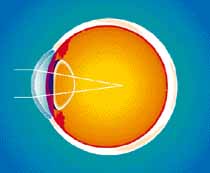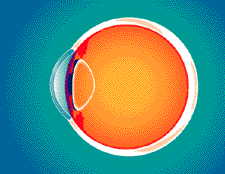Post Operative Experience

| Staring Into a Laser Beam
Post Operative Experience |  |
| --Scott Rainey | |
| After the operation, I worked at my computer, drove my car and generally did business as usual. There was some pain but it was easily manageable with the eye drips and the oral pain meds. I was able to also drive myself to the clinic for my 24 hour and 4-day post-op checkups. Vision through the "bandage contact lens" is much like looking at the world through REALLY dirty eyeglasses. I found that I could focus well enough to read street signs, without glasses, but for driving etc, I wore my prescription sunglasses, which made vision out of the corrected eye REALLY blurry, however as my untreated eye saw things in normal sharpness, having the blur from the treated eye to approximate 3D vision was preferable to no stereo vision at all, as would occur had I been wearing an eye patch. I'm sure the clinic would forbid it, but I believe that I could have driven myself home from the actual operation. They give you an eye shield to tape over your post-op eye at night to prevent you from dislodging the "bandage contact" On my first night that was a problem for me, as I'd fallen asleep on the sofa watching TV. I awoke at about 1 AM and toddled off to bed without putting on the shield. Whooooops! At 4:00 AM I was painfully aware that the bandage contact had slipped off. Finding the contact, and putting it back in, was not pleasant, Had I never worn contact lenses, it might even have been a big problem. As it was, I found the lens, cleaned it, and replaced it in my eye with a lot of the pain killer eye drops and slept through the rest of the night. I entered the clinic with some concern about the slipped bandage contact lens, but was assured that the brief departure of the bandage contact was no big deal. They replaced it with a fresh one, and gave me further instructions on post operative care for my treated eye. The rest of day two, I didn't feel much like working at my computer screen, and followed doctors orders and slept the better part of the day. The second night I was less sloppy about putting on the shield. Got a good nights sleep, and felt very good in the morning. I used the pain killer eye drips only twice on Wednesday, which is both what the doctor ordered, and what felt appropriate. I was 20/60 on Friday. By the following Monday I was 20/40 - legal to drive in Oregon. That of course was an improvement, but still pretty fuzzy. I really hate seeing the world through dirty glasses, but it improved noticeably every day. Doc Rich says that the wound heals from the perimeter to the center, then stabilizes over time, just like a scraped knee. It is all a well known process that they factor into the zap equation.... I suppose that a preliminary test of the individual's healing power/patterns would be appropriate, perhaps a small burn at the edge of the cornea to see if keloids occur, but other than random infections, that's the only complication that causes imperfect results they say. For the next month I am to put in sterile saline eye-drops about every hour. As sloppy as I am, about pills and vitamins, that works out to every couple of hours because I simply forget until the eye begins to feel dry The clinic runs an informational seminar. The free seminar is surely worth your time if you have any interest in this process at all. I did not attended one ahead of time, but did go before the second zap. It was worth it just to get the statistical package they present on successes, and complications. By Wednesday night (post-op day nine), my vision, while not perfect was very good. I put the patch over the untreated eye, and walked around and was well pleased. For the first time, I drove the car, without eyeglasses. Thursday things were again slightly better. Bright light caused a haze, but indoors things were very good indeed. I took an old pair of eyeglasses and popped out the right lens. Convergence of left and right eye images was pretty bad for about a week, but ultimately it became a good way to navigate in the "in between surgeries" times An amusing sidebar occurred on Thursday: A good friend reported that one lens of his new one-hour eyeglasses exploded on his face while he was playing cards. He's ok, just a couple of minor scratches to his eyeball which should heal in 48 hours but it reminds me of how nice the world will be without glasses. Feedback from his friends on sharing the news that his eyeglasses had exploded on his face brought this rejoinder: "You mean there's a Windows95 for Eyeglasses?" My right eye continued its post-op improvements, noticeably day by day, I wore the one-lens eyeglasses and I could work a normal 15 hour work day. After post-op day 14 I was actually working on my computer screen as many hours a day (12-15) as I had been before the surgery, even though I was working with only one fully functional eye and one fuzzy eye. I could go without glasses fine for driving, TV, wandering around the house and movies. Each of those activities worked almost as well without any glasses as with the one-lens eyeglasses. However, when I closed the uncorrected eye, I could still not see the computer screen well enough to read it with the corrected eye alone. If you don't get both eyes done the same day, as I did, you'll probably want to pop one lens out of an old pair of glasses to use do this between surgeries. It was ok but weird. Convergence (focusing both eyes on the same spot) was VERY bad at first until my brain learned to adjust - which took a couple weeks. It was kind of odd to have to slightly cross my eyes to bring the world into best focus for the corrected eye. Post Op day 15: It occurs to me that I should get reading glasses, and when I tried them at a retail store, I was astonished that the corrected eye can read newspaper print. Being a frugal shopper I went to Costco's to check their reading glass prices. Indeed, where Freddy's sold them for $16 or $22, Costco sells two for $12. I got the second weakest reading glasses [+1.50 diopters], but went back later for weaker +1.25's. Post-Op day 20 I finally decided to take the clinic up on their offer of free disposable contact lenses for the uncorrected eye. These are absolutely the most comfortable contact lenses I've ever worn, but they do not correct my astigmatism so that probably is a big factor. With the single contact lens, convergence was better, but not perfect. I could work at the computer screen all day long with both eyes open, looking through my new reading glasses. These disposable lenses are so thin that putting them in is a problem, but once installed, stay comfortable all day. After two days of working with the contact lens and reading glasses; my lovely 21" NEC Multisynch XP21 decided it needed a vacation had to spend a few days in the repair shop. Naturally this happens on a Friday so the monitor had to wait till Monday to even have a ride in the car to go to the shop. I had to use my 15" backup monitor. Bletch. Well at least my corrected eye had healed to the point where I can now see well enough to use the little monitor. Sharp focus is still a bit of an issue. The eye with a contact lens will never be sharp due to my astigmatism; however I still had to slightly cross my eyes to bring the corrected eye into best focus. It was one of those RTFM situations (Read The Flipping Manual). I had not attended one of the clinic's informational seminars wherein I would have been told about the healing process. I think that the clinic should have a better hand out about this, but since they do (allegedly) cover this at the seminars, I was responsible for my own disappointments. Recall the earlier statement that after an Excimer Laser zap, the eye heals just like a scraped elbow? Time to expand on that. Your body's first priority is always close that opening! Openings (cuts & scrapes) are very bad, because infections sneak in that way. Once the wound is closed the next job is to rebuild the underlying tissue. Back to your elbow for a moment. Healing is not done when the last scab falls off. Your skin is closed but not completely rebuilt. For 4-6 months a rebuilding process goes on under the skin which fills in all the tissue which was scrapped off. This means that a formerly near-sighted patient is far-sighted for the first few weeks, getting to about 97% stabile at around 12 weeks. Dr Rich told me that I was healing ahead of schedule, and far faster than he was from his own Left-eye PRK 5 weeks ahead of mine. I walked out of the clinic a very happy camper indeed. |
Home Page
|

Focus problem in a nearsighted (myopic) eye | 
Animated GIF of PRK process (91k) |